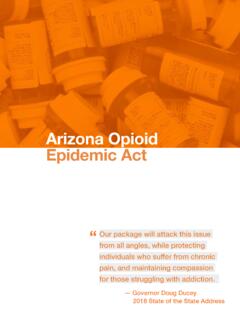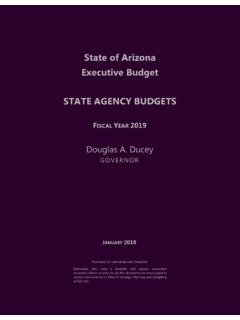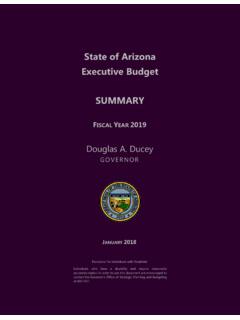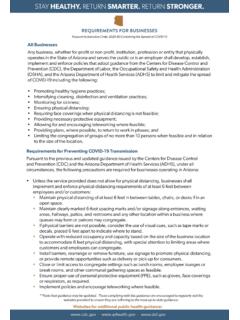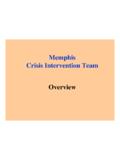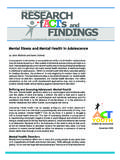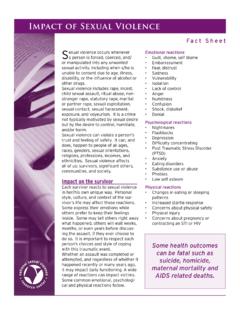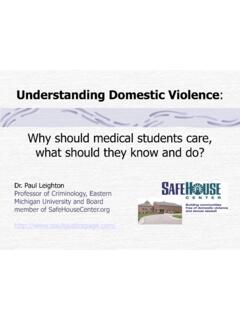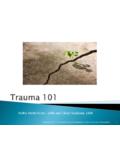Transcription of Arizona Opioid Epidemic Act - Office of the Arizona ...
1 Arizona Opioid Epidemic Act Our package will attack this issue from all angles, while protecting individuals who suffer from chronic pain, and maintaining compassion for those struggling with addiction. Governor Doug Ducey 2018 State of the State Address An Epidemic In Arizona , Opioid use, overdose and deaths have increased at an alarming level over recent years. Last year, the state experienced the highest number of deaths in more than a decade. It s a national Epidemic and an Arizona crisis and it s one we must address with care and urgency. 812 Arizonans died of a suspected Opioid overdose5,202 Arizonans suffered a suspected overdose on opioids455 Arizona babies were born addicted to opioids Real lives. Real people. Between June 2017 - January 2018: A potent drug mis-prescribed, overprescribed, and misused. 6,000,000+The amount of opioids that four doctors wrote over a 12-month period in a county with a population of 200,000 percentage of heroin users in treatment that started with painkillers, according to a 2014 study by the Journal of the American Medical Epidemic that impacts every zip code, every county 3,114993104 - 2351 - 103 Reported overdoses from June 15, 2017 through January 11, the last few years, Arizona has taken a number of steps aimed at preventing and treating Opioid addiction.
2 Through legislative action, executive order, and directly working with the citizens of our state, we ve made meaningful progress in implementing policies to combat the Opioid Epidemic . It s time to call this what it is an emergency. Following the release of data that showed a 74 percent increase in Opioid overdoses since 2013, Governor Ducey declared a statewide emergency to address Opioid overdoses and deaths in June 2017. The declaration was followed by an executive order mandating real-time reporting of Opioid overdoses to better understand where the problem areas are and inform a path-forward to save lives. As part of this public health emergency, the Arizona Department of Health Services was instructed to identify ways to: prevent prescription Opioid drug abuse through appropriate prescribing practices, develop guidelines to educate healthcare providers on responsible prescribing practices, expand access to treatment, especially Medication Assisted Treatment (MAT), and reverse overdoses through the distribution of All-Hands-on-Deck Approach In developing a response to the governor s direction, the Arizona Department of Health Services (ADHS) engaged with medical officials, law enforcement, community leaders, chronic pain sufferers, pharmacists, victims, individuals addicted to opioids, substance abuse treatment experts and Action Engaging Arizona Through the emergency declaration and comprehensive stakeholder process, Arizonans began engaging in a months-long discussion on how best to address the Epidemic .
3 To facilitate the statewide discussion, ADHS developed several mechanisms to allow for partner interaction and information distribution including a dedicated webpage, The webpage organizes resources and allows stakeholders to quickly access up-to-date Opioid -related information including FAQs, administrative rule proposals and a recently released 50 State Review on Opioid -Related Policy. To date ADHS has engaged with over 1,350 Arizonans about this issue and held approximately 50 meetings with stakeholders and partners. Based on this collaborative work, in September 2017 ADHS issued its Opioid Action Plan, a comprehensive strategy that responds to the governor s direction and included detailed recommendations to reduce Opioid misuse, promote safe prescribing and dispensing, and improve access to treatment. The recommendations serve as a basis for the legislative package proposed during the special session declared by the Health Emergency 3 Actions-To-DateCracking Down on Doc Shopping In 2016, nearly 1,000 Arizonans were in possession of as many as four prescriptions at a time from four different doctors.
4 In May 2016 Governor Ducey signed a bill to target doctor shopping by requiring physicians in Arizona to access and update the prescription drug database before prescribing a controlled substance to a patient. Combined with efforts from the Board of Pharmacy, the number has dropped to below 100 people each Overdoses, Saving Lives Since the governor s emergency declaration in June, Arizona Department of Health Services has trained more than 1,200 first responders to carry and administer Naloxone and provided more than 5,100 Naloxone kits to law enforcement agencies to help reverse Medication Disposal In partnership with Walgreens, the state established 18 Safe Medication-Disposal Bins located throughout Arizona . These bins allow for the disposal of opioids and other prescription drugs to minimize the likelihood of misuse or diversion. Drug Overdose Review TeamGovernor Ducey signed legislation establishing a review team to investigate every drug overdose death in Arizona .
5 The team is comprised of the state s top health, prevention, and public safety officials and collects data on drug overdoses and coordinates with local stakeholders to prevent future overdose on First FillsThe governor issued an executive order that limits the first fill of addictive prescription opioids to seven days in all cases where the state is the and Prevention Arizona s Healthcare Cost Containment System (AHCCCS) is the leading payer for substance abuse treatment in the state. Among the services provided are early intervention, behavioral health counseling, and detoxification. The investment has increased significantly over the past few : $162,939,257 | 2016: $207,603,832 | 2017: $236,316,548 The Department of Child Safety (DCS) offers substance abuse treatment to parents who are working toward reunification when addiction is a factor. The Department of Corrections (ADC) provides additional substance abuse treatment to inmates,Collectively the state invests $265 million annually in substance abuse treatment and prevention.
6 4 The Arizona Opioid Epidemic Act We ve all heard the first-person stories of individuals who have been impacted by this crisis. Many here today have been personally impacted. But there are so many others stories we haven t heard -- because the individuals impacted didn t survive. More than 800 just last year. This bill is for them. Governor Doug Ducey at the signing of the Arizona Opioid Epidemic Act PageAccess to Treatment 6 Access to Naloxone7 Preventing Addiction for Arizona Youth8 Targeting Bad Actors9 Good Samaritan Law10 Angel Initiative11 Prescriber Education12E-Prescribing13 Responsible Dosage Limits145-Day Limit on First Fills15 Expediting Prior Authorization16 Opioid Packaging17 Stopping Doctor Shopping18 Preventing Illegal Use195 Access to TreatmentThe Problem Inconsistent Continuity of Care Continuity of care for individuals receiving medication assisted treatment (MAT) can be difficult. Individuals who have sought treatment for addiction and are receiving MAT are not always eligible to reside in licensed behavioral health residential facilities or recovery homes.
7 Overdose Treatment When a patient receives treatment in an Emergency Room for an Opioid overdose, hospitals focus on addressing the immediate issue. Treating the overdose however, does not address the underlying addiction. Currently, only 47 percent of overdose patients are referred to behavioral health providers upon release. Uncertain Treatment Facility Access The Opioid Epidemic impacts all zip codes and all counties. Currently, there is not a single report detailing the state s treatment assets. An Underserved Population While AHCCCS is the largest payer for individuals with substance use disorder, there are still people not eligible for AHCCCS that are uninsured or underinsured and are unable to receive treatment due to the Solution Caring For Those Who Have Sought Treatment Require licensed behavioral health residential facilities and recovery homes to develop policies and procedures that allow individuals on MAT to continue to receive care in their facilities.
8 Treating an Overdose AND Treating Addiction Require healthcare institutions to refer a patient to behavioral health services after treatment of an overdose. Develop an Inventory of Treatment Facilities Require ADHS to collect information on inpatient and outpatient treatment facilities, identify gaps in access to treatment, and publish a public report with recommendations for improving access to treatment. Requires each treatment facility to submit a quarterly report that includes information regarding the number of days in the quarter that the facility was at capacity and unable to accept referrals for treatment. Closing the Access to Treatment Gap This legislation includes an appropriation of $10M that will go to providing treatment for uninsured or underinsured Arizonans in need of treatment. This appropriation is available Arizona is expanding access to Opioid treatment programs throughout the state using grant funds from the Substance Abuse and Mental Health Services Administration.
9 In October 2017 the first of five, 24-hour centers for Opioid treatment, opened to address the growing need for access to Opioid use disorder to NaloxoneThe Problem County health departments, probation officers, detention officers, police aides, crime scene specialists, crime scene laboratory employees and other law enforcement/department of corrections employees are not currently permitted to administer Naloxone. The Solution Authorize these ancillary law enforcement and county health departments to administer 3,429 Naloxone doses administered outside of the hospital by emergency medical services, law enforcement, and others from June 2017 through January 2018. 86%The percentage of patients who survived an overdose received Naloxone pre-hospital. Increasing access to Naloxone has been a top-priority as Arizona works to combat the Opioid Epidemic . From law enforcement to an individual at risk of experiencing an Opioid -related overdose increasing access to this Opioid antagonist is a proven way to prevent drug overdose Addiction for Arizona Youth The Problem According to the National Center on Addiction and Substance Abuse, 9 out of 10 people with substance problems started using by age 18.
10 The Solution Directs ADHS to engage with local education agencies in the development of abuse prevention initiatives. This legislation: Requires ADHS to create an Opioid abuse prevention education initiative. Appropriates dollars to the Attorney General for the purpose of awarding grants for community Opioid education and prevention efforts8 Background 7xPeople who began using addictive substances before age 15 are nearly seven times more likely to develop a substance problem than those who delay first use until age 21 or prescribing rates for prescription opioids among adolescents and young adults nearly doubled from 1994 to 2007. According to the National Institute of Drug Abuse, most adolescents who misuse prescription pain relievers are given them for free by a friend or relative. The American Society of Addiction Medicine released the following statistics: Ta rg e t i n g B a d A c t o r sThe Problem There are bad actors who are making a living off of writing dangerous prescriptions.
